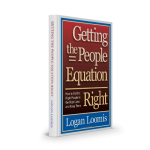
Yellow Flags: How “Personal Fouls” Can Sabotage Success
January 23, 2019
Resisting the Monkey: How to Stop Taking on the Work of Your Direct Reports
March 20, 2020Just a few years ago, a Gallup report on the state of the American workforce estimated that the U.S. lost $483B to $605B in productivity due to actively disengaged workers.[i] That’s a big number, and it has sparked a lot of discussion about increasing workplace engagement. Managers naturally want to do this, but what exactly does it mean?
Is it even possible?
A lot of the commentary proposes that the solution to worker disengagement is simply better leadership. And while bad leadership can certainly hurt engagement, that doesn’t mean that good leadership creates engagement. Let me explain. You see, engagement is a lot like dating.
Employee engagement is like dating.
When you’re dating someone, sometimes there is real connection—a real fit. There’s passion, effective communication, and a good amount of common ground between you. You might hit bumps along the road as you grow together, but the baseline compatibility is always there to help you through, and the passion you feel for each other motivates you to improve.
Now think about a slightly different situation. Let’s say you’re dating someone who’s “objective attractive,” as the millennials say. (I haven’t dated since the 1970s, so I think I’m using the term correctly.) On top of that, you have some things in common. But there’s something missing—the passion.
think I’m using the term correctly.) On top of that, you have some things in common. But there’s something missing—the passion.
No matter how you reframe the situation, no matter how good the person is to you, you’re just not excited to be around them in the way you know you’d like to be. As the title to the romantic comedy says, “He’s Just Not That into You.”
Disengaged employees at work are similar. They do the job, but they’re not inspired. They meet expectations, but they don’t exceed them. And just like in a dating relationship, there’s only so much you can do. You just can’t engineer passion.
Employee engagement is largely a function of job fit
Research by Dan Harrison, PhD, shows that when I’m in a role where 75% of the time I’m doing activities I enjoy, I’ll be engaged in the work and three times more likely to succeed in the role. This is what Harrison considers a good job fit. Determining job fit is a critical factor in increasing workplace engagement and getting the right people in the right jobs.
But how do you do that?
One way to do it is through predictive analytics. Personally I use the Harrison Assessment, which employs Joy Performance Theory.
Joy Performance Theory says that when we enjoy something, we tend to repeat it.
Joy Performance Theory is rooted in our natural behavioral tendency to do the things we like to do and avoid—as much as we possibly can—the things we don’t like to do. Joy Performance Theory posits that when we enjoy something, we tend to repeat it. As a result, we get better at it—we improve. When we get good at something, we typically get positive feedback. That tends to make us enjoy it more. And the virtuous cycle continues.
 For instance, think of something you really like to do. Nobody has to tell you to do it; you’re already doing it whenever you get the chance. It’s natural. It’s fun. It gets you engaged.
For instance, think of something you really like to do. Nobody has to tell you to do it; you’re already doing it whenever you get the chance. It’s natural. It’s fun. It gets you engaged.
We all know an engaged employee when we see one. They have a positive, emotional commitment to the job. You often see them fully absorbed in their tasks, and when they talk about their work, they’re enthusiastic. These are the employees who take positive action to further the company’s reputation and interests. These are the people we all want on our teams.
Now, think of something you don’t like to do. You likely resist doing it. You may procrastinate or just muscle through it, but that takes a lot of energy. You’re disengaged.
Disengaged employees tend to not like their jobs. They are the ones who typically show up and do just what is required—no energy or passion in their work. You can probably think of a few people on your team who fit the bill. We all can, because, as Gallup research confirms, disengagement is very common.
The Harrison Assessment applies Joy Performance Theory by identifying behaviors that you naturally enjoy and showing how they compare to the behaviors that typically lead to success at a particular job. Knowing your natural tendencies then helps you to find a job for which you’re well suited—as well as areas for improvement in your current work.
I struggled for 10 years at a law firm—and a Harrison Assessment could have told me why.
I recently read an article on how to cope with a job you hate. Although the article didn’t mention it, the best coping strategy is to get a job where you enjoy most (at least 75 percent) of the activities. But there are a lot of reasons people stay in a job they hate.
For instance, you might not be able to get a job that pays as well as the one you hate. Or, you may have education or training in an area where you don’t want to abandon the time and money you’ve already invested.
That was the case with me. I had invested a lot of time and money in a law degree, and after law school I joined the corporate section of a large law firm.
The reality of practicing law was not what I had expected.

The corporate practice required a great deal of attention to detail. I found the work tedious. Had I had Harrison Assessment data at that time, it would have told me that this was not going to be a good job fit, and it would have told me why: my “precise” score on the Harrison Assessment (enjoyment of work that requires being exact and the tendency to be detail oriented) is one of my lowest scores.
That said, I’m also highly self-motivated and persistent. When I was faced with a lot of detail-oriented work at the firm, I muscled through it—for the better part of ten years. I gained a high level of expertise by muscling through, and I was enjoying a high level of professional and financial success as a result even if I was not enjoying the job.
But one day, I realized that something wasn’t right.
I was working on a transaction with two of the most senior partners in the firm. These people were legendary in the legal community. And on this day, they were getting very enthusiastic and engaged in discussing the legal implication of what I considered a minute—and unimportant—detail of the transaction. I just wanted to get it done. But as I watched them, I realized that I was never going to have that level of engagement with the law. I thought to myself, I just don’t have that DNA.
Fortunately, I left the firm and ultimately found work that I love and that is more suited to me.
Back to the main question—can you “fix” employee disengagement?
Not everyone has the opportunity to leave an unsuitable job—hence one of the problems of a disengaged workforce. And unfortunately, managers tend to misunderstand what’s going on with these employees. Because they want a highly engaged team, they tend to view disengaged employees (those that do enough to get by) as unsatisfactory.
But here’s the thing: if you are doing enough to get by, that is the very definition of satisfactory work.
The problem tends to lie with managers who themselves are high performers. Because of their own personal success model, they tend to view excellent work as satisfactory and satisfactory work as unsatisfactory. As a result, they may get frustrated when their good leadership practices don’t spark better, more engaged performance. The people continue to do the job, but they’re not inspired. They meet expectations, but they don’t exceed them.
The hard truth is that there’s no way to make your employees love their jobs. If a person is doing what you hired them to do, yet your expectations are not being met, you may need to rethink your expectations of that person. If engagement is one of your expectations, the solution lies in a more informed hiring process that looks beyond skills and experience and considers job fit.
The best solution to employee disengagement is to hire the right people.
I highly encourage you to use Harrison Assessment data to make future hires who have a high probability of being fully engaged in the job. Once you have people with a natural tendency to be really engaged in the job—a good job fit—use good leadership practices to keep them there. In other words, you need to have the leadership ability to not screw it up. That means that you must possess strong leadership behaviors such as communication, appreciation and actively helping the people you lead to grow and develop.
 You can learn more about these leadership competencies by reading my book, Getting the People Equation Right: How to Get the Right People in the Right Jobs and Keep Them.
You can learn more about these leadership competencies by reading my book, Getting the People Equation Right: How to Get the Right People in the Right Jobs and Keep Them.
So, bottom line, if you want to increase productivity by having a highly engaged team, the solution lies in hiring the people who have a good job fit and then leading in way that makes them want to work for you.
[i] Gallup, Inc. State of the American Workplace, 2017, p. 19


